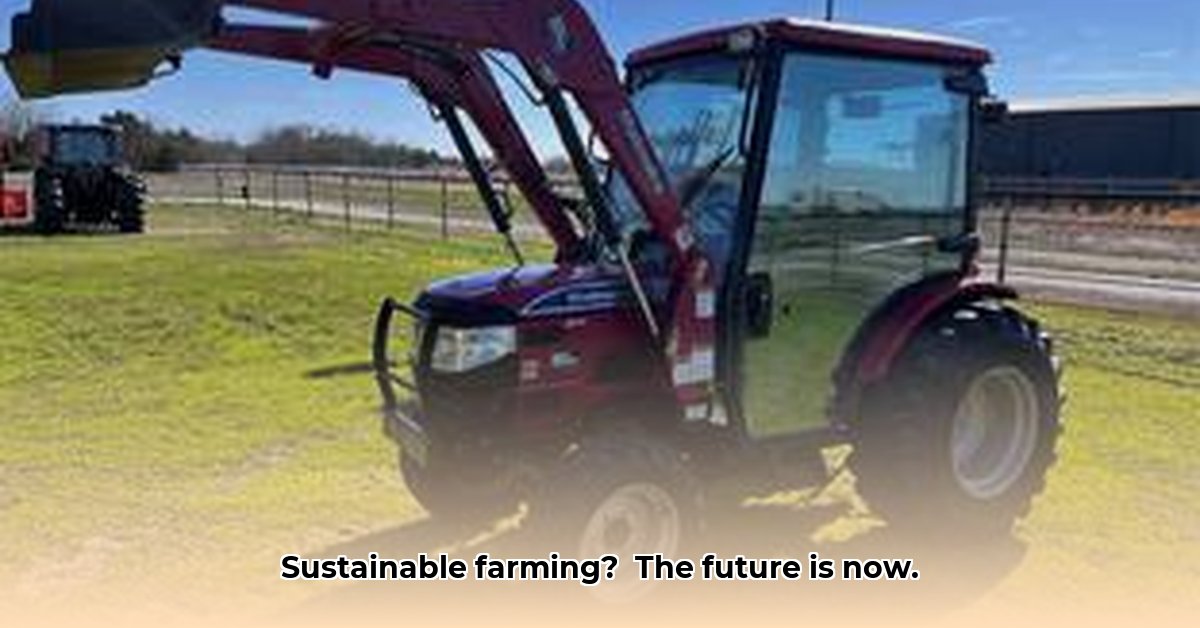
Finding Your Path to Sustainable Farming in North Texas: The Used Tractor Advantage
Starting or expanding a farm in North Texas presents significant challenges, particularly for those committed to sustainable practices. The initial investment in equipment can be daunting. But there's a smarter, more sustainable, and significantly more affordable path: used tractors. North Texas Tractor and Equipment (NTTE) offers a vital resource, connecting farmers with reliable, pre-owned equipment that enables them to build thriving, eco-friendly operations. While buying used equipment does present challenges, understanding those challenges and mitigating the risks can unlock significant opportunities. For additional equipment options, check out these rototiller options.
The Used Tractor Landscape: Balancing Opportunities and Risks
The used tractor market provides a crucial entry point for small-scale and beginning farmers, offering substantial cost savings compared to buying new. However, it's vital to acknowledge the potential drawbacks. Older tractors may lack the precision technology found in newer models, potentially impacting efficiency and increasing resource use (leading to higher environmental impact). Furthermore, higher repair costs and difficulties in sourcing parts are realities that must be factored into any decision.
Navigating the Challenges: A Practical Approach
The following table summarizes the key challenges and offers actionable mitigation strategies:
| Challenge | Potential Impact | Mitigation Strategy |
|---|---|---|
| High Repair Costs | Reduced profitability, unexpected downtime | Thorough pre-purchase inspection, establishing a dedicated repair fund, proactive preventative maintenance. |
| Parts Availability Issues | Extended downtime, increased repair costs | Developing relationships with multiple parts suppliers, exploring alternative parts (e.g., aftermarket parts), maintaining a stock of common replacement parts. |
| Lack of Precision Technology | Inefficient resource use, increased environmental impact | Prioritize tractors with upgrade potential, consider renting precision equipment or leasing newer models for specific tasks. |
| Environmental Impact | Higher fuel consumption, increased emissions | Selecting fuel-efficient models, exploring alternative fuels such as biodiesel, adopting best practices for minimizing fuel consumption. |
Your Step-by-Step Guide to a Successful Used Tractor Purchase
Choosing the right used tractor is a pivotal decision. Following these steps will help ensure a successful outcome:
Define Your Farming Needs: What crops will you grow? What farming techniques (no-till, conventional, organic) will you employ? This directly impacts the type and size of tractor you'll need.
Establish a Realistic Budget: Determine a realistic budget that encompasses not only the purchase price but also anticipated repair costs, maintenance, and potential financing fees.
Research Tractor Models: Identify models that meet your needs and budget, prioritizing fuel efficiency and any potential for future technology upgrades (GPS, precision application). Consult resources and online forums for reviews and comparisons of specific models.
Conduct a Thorough Inspection: Before committing to a purchase, conduct a comprehensive inspection. If you lack mechanical expertise, engage a qualified mechanic to assess the tractor's condition. Don't hesitate to ask detailed questions about maintenance history and any known issues.
Negotiate Effectively: Research market values for comparable tractors to establish a fair price. Approach negotiations with confidence, leveraging your knowledge and the pre-purchase inspection findings.
Secure Financing (If Necessary): Explore available financing options, including government grants and loans for farmers (like those offered through Farm Credit). Compare interest rates and repayment terms to find the most suitable plan.
Partnering with North Texas Tractor and Equipment: Transparency and Trust
NTTE’s success hinges on transparency and building trust with farmers. By providing comprehensive information about tractors' conditions, maintenance histories, fuel efficiency, and any potential issues, NTTE empowers farmers to make informed decisions. This upfront disclosure builds confidence in both the provider and the potential of the used equipment itself.
Long-Term Strategies for Sustainable Success
Sustainable farming isn’t just about the initial equipment purchase; it’s a long-term commitment requiring a holistic strategy:
Prioritize Upgrade Potential: Choose tractors that allow for future upgrades, incorporating modern technologies as your budget allows.
Embrace Preventative Maintenance: Proactive maintenance reduces costly repairs, maximizes equipment lifespan and minimizes overall environmental impact.
Explore Alternative Fuels: Consider the use of biodiesel or other alternative fuels to lessen your reliance on fossil fuels and reduce your carbon footprint.
Utilize Government Assistance: Explore government programs and subsidies that can support sustainable farming practices and equipment upgrades.
Case Studies: Real-World Success (This section will feature inspiring case studies of farmers who have successfully adopted sustainable practices using used equipment sourced from NTTE or similar providers.)
Minimizing the Environmental Impact: A Focus on Sustainability
While buying used equipment inherently reduces the environmental impact compared to buying new, adopting additional practices further enhances your sustainability efforts.
Fuel Efficiency and Emission Reduction:
Choosing fuel-efficient models is crucial. Older tractors often have lower fuel efficiency, leading to higher emissions. By using a fuel-efficient model and adopting best practices for fuel consumption, you can lessen your environmental impact significantly.
Maintenance and Extended Lifespan:
Regular maintenance is vital. This practice extends the lifespan of your tractor, reducing the need for frequent replacements, and therefore minimizing resource depletion and waste.
Precision Agriculture for Resource Optimization:
Precision agriculture techniques (GPS guidance, variable rate application) dramatically improve resource use, reducing waste and environmental impact. Even if your older tractor lacks these features, there are many opportunities to add these technologies cost-effectively.
Responsible Disposal of Parts:
When parts reach the end of their life, dispose of them responsibly. Recycle or properly dispose of old components to minimize landfill waste and protect the environment.
The Future of Sustainable Agriculture in North Texas
The future of sustainable agriculture depends on collaboration. Farmers, equipment providers like NTTE, and government agencies must work together, sharing information, promoting incentives for sustainable practices, and fostering ongoing education. This collaborative approach will lead to a more environmentally responsible and resilient agricultural landscape in North Texas.